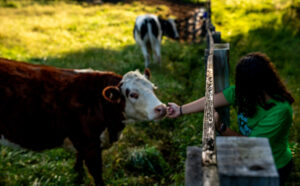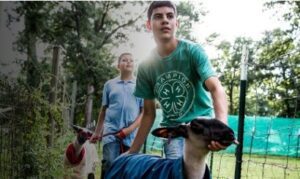While riding horses, we came across a wild hive in a water meter box that the water company would probably kill. So I rescued it and brought the bees to my farm and set them up in a ten-frame Langstroth hive box, alongside the other 5 hives in my apiary. The extraction was challenging because the bees had sealed a whole concrete water meter box with propolis, a special bee glue, leaving only one entrance. So prying the lid off was very difficult. I wedged a hammer under the lid after breaking the propolis seal with a screwdriver. I’m a big guy and it took all my strength. Can you imagine that tiny little bees can make something so strong? I cut their honeycomb out of the sprinkler box and secured it with rubber bands to empty frames in my hive box.
After about two weeks, I checked on the bees and they had attached all their honeycomb to the frames with propolis and chewed off the rubber bands. They pushed the rubber bands out of their front door for me to clean up and remove. It is amazing the way the girls take out the trash – they are fastidious creatures!
I check on my girls every couple of weeks. So I noticed that they were having a little trouble with varroa mites – time to add some powdered sugar to the hive! I just use a flour sifter with about one cup of powdered sugar and dust the whole hive with it. The mites get all covered in the sugar and cannot crawl around. They immediately drop through the screened bottom where the ants are waiting to feast on them – no more hitchhiking mites!
My bees had become a bit aggressive so I ordered 6 new queens from Old Sol Apiaries in Oregon to re-queen our hives. About 90% of our wild honeybee population in San Diego is Africanized and very aggressive. Re-queening means we put a tame European queen bee into a colony of wild Africanized bees, who then accept the queen as their leader. This results in a genetic cleansing of the hive as the old aggressive bees die off and the new queen’s gentle offspring replace them. One part of this that is fascinating is that the new queen arrives in a little cage with a sugar plug called a candy release. She eats it from the inside to stay alive and the bees in the hive eat the plug from the outside to release her. By the time she emerges, they are so excited to accept their new leader!
By far, the sweetest (and stickiest) part of beekeeping is the annual honey harvest. When the bees determine that there is the perfect amount of humidity in the honey, they seal it in little hexagon-shaped cells for safekeeping. When I see those caps, I know it’s go time. This is a great time for teamwork as there are plenty of jobs for everyone. After we remove the honey filled frames from the hive, we have to gently cut the wax caps off each frame with a hot knife. Then we put four frames at a time into our extractor, which is like a big barrel with a crank on top. By turning the crank for a very long time, it spins all the honey out using centrifugal force and it runs down to the bottom of the barrel. We then run the honey through many filters from course to fine until it is very clear and looks like liquid sunshine. Then we carefully bottle it into little honey bears. No matter how careful we are, there is sticky honey everywhere, but it is so worth it!
So now, after all these fun summer adventures together, I hand my honeybees over to my mother and sister to care for and tell all the girls goodbye until winter break. How did I end up having to bid farewell to 80,000 honeybees, you may ask? I learned to be a beekeeper from my 4‑H leader, Jamie Sternberg, when I was 12 years old. She opened up a whole new world for me and sparked a passion for beekeeping that I am certain will last a lifetime. I’ll close with the words of that huggable old honey-lover himself, Winnie the Pooh, “How lucky I am to have something that makes saying goodbye so hard.”
















